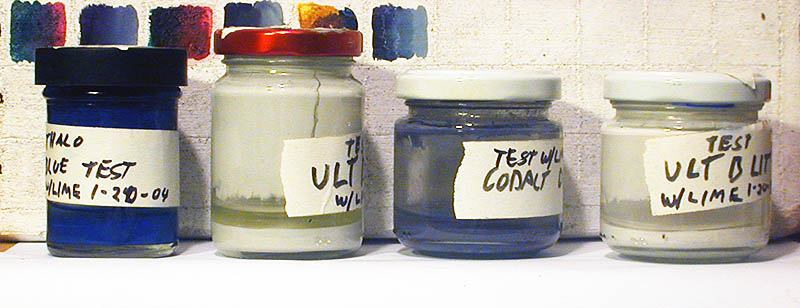| The Blue Brick 1-16-04 The base coat has ultramarine blue light added to the mortar. The top coat, when it's ready to paint, it will have sections with a wide 'V' giornate cut and removed down to this base rough coat that I applied fairly smoothly.
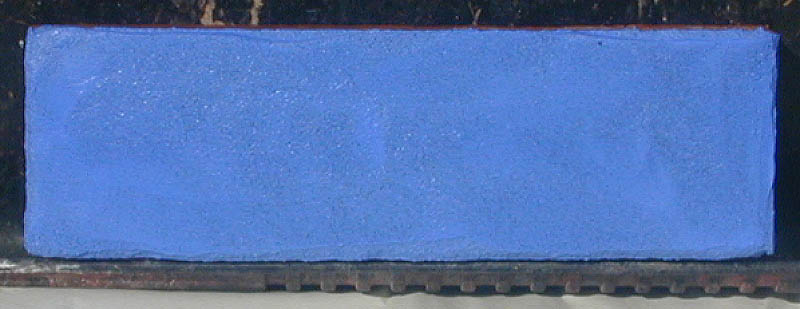
1-20-04, Four days later this is what the blue brick looked like. 
Now I'm doing a color test in a jar_of_lime for all my blues, cobalt blue deep, thalo blue, ultramarine blue light and ultramarine blue deep. Each has the same amount of fresh lime, pigment and water. Cobalt blue Light just arrived, I'll test it next. Because of this ultramarine blue failure I am testing all colors in a jar of wet lime milk. 
Bad news.. both ultramarine blues turned white in wet lime, the cobalt blue deep turned a deep gray. These colors were bought from Zecchi. Senopia's Ultramarine Blue Dark for lime has a problem also, it turned lighter after 4 months on a mural.
Only the thalo blue remained unchanged for fresco work. A later test of Cobalt blue Light stayed the correct color. New test, 4-18-4. Re-test Zecchi Ult blue and ult blue lite, indanthrone blue, permanent red, Quin. violet, manganese violet, cobalt violet, quin coral.
Both Zecchi ultramarine blues turned white.
Senopia's Ultramarine blue and dioxine purple arrived, The test has started, 4-25-4.
4-25-4 to 5-4-4, These new tests all kept their color. Priderit Yellow PT157 Senopia. Irgazine Green PY129 Senopia. Irgazine Red PR254 Senopia and Thioindigoid Red PR88 Zecchi.
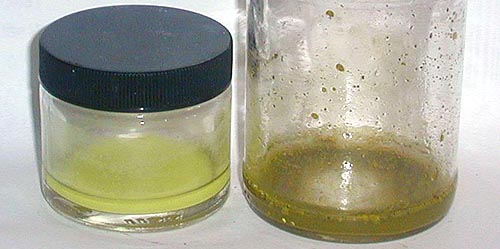 4-25-4 to 5-16-4, Quinacridone Coral turned warmer to yellowish, Quinacridone Red went brown and Napthol Red turned cooler toward magenta. Good colors, but not fresco colors. 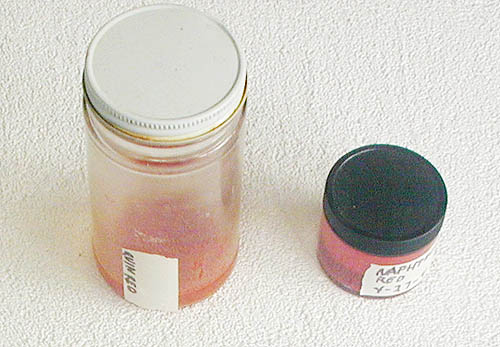 10-13-04, all the Irganzine colors are lime safe. 10-30-04, PR122 by Sennelier is the perfect magenta and is very stable in lime. 10-30-04 Phthalo Green PG7 precipitated. This is important for fresco painters because they use dry pigments. The reason I made this test is because I wasn't satisfied with the painting quality of the pigment, I could see the darker side in washes and it tended to clump after it was ground just setting in limewater. It just wasn't a clean color. Now I will only use the precipitated PG7. It will be easier to wet and will give a cleaner green. This problem doesn't happen in other media because the pigment is kept in suspension. Here is the test and results.
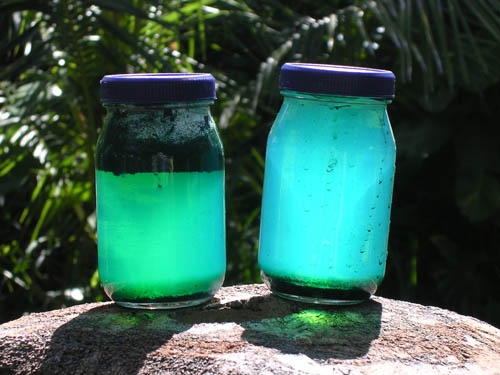 I separated dry PG7 Thalo green by adding water and gum Arabic to wet it, the mix was shaken and stirred, then left to settle. Here are the settled pigments in water.
 The floating pigment made an island, the top most particles dried. Remixed with arabic to make paint, "A" is what I got from floating pigment. "B" is pigment from what mixed with water and didn't float. "C" is the original dry powder in gum arabic. A. Shows a decidedly blacker color. B. Is a smoother painting pigment with no black appearance in the buildup. C. Clearly, this is a mix of the two. |
